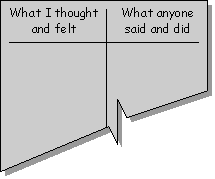
Values checklist 1
This is a resource file which supports the regular public program "areol" (action research and evaluation on line) offered twice a year beginning in mid-February and mid-July. For details email Bob Dick bdick@scu.edu.au or bd@uq.net.au... in which you have the opportunity to analyse and learn from an interaction which you would like to have handled better, or more easily, or more satisfyingly than you did
Overview of process
- Answer
the questionnaire in the top row of each set of 5 boxes,
following the instructions below
- Choose
a system to analyse, for instance using a two-column analysis
as described later
- Answer
the questionnaire in terms of the behaviour or observations
from the situation you have analysed, using the lower row of
boxes for each pair of items
- Choose
those items where there is a difference between the two ratings
for an item, and where you are surprised at the difference
- Develop personal action plans to make use of the insights
(You can use this checklist in conjunction with the values workbook if you wish)
[ back ]
Take a few minutes to respond to the following instrument. It describes actions which have implications for learning. Read each pair of items, and decide how you would like to be able to behave (you may or may not behave in this way).
If you would like to favour one of the two actions strongly, and this is important to you, place a tick in the space near that item. If you favour one item only to some extent, or you favour it strongly but don't regard it as important, tick partway between that item and the middle. If you genuinely can't decide, or think an item is completely unimportant, tick the middle of the space.
You will return to this later, and compare your actual behaviour in the situation you analyse to the preferred behaviour you indicate now. These items are for your own learning; you are able to choose the extent to which you reveal them to others.
You will probably get the best results if you do not agonise too long over any one response.
Note that you are being asked to respond in terms of how you would like to behave, not necessarily in terms of how you think you actually behave.
Note, too, that this is an instrument for reflection and learning, not for research. It is not known how accurate it would be if used as a measure.
The easiest way to use it is to print it out.
[ back ]
Model
1 Model 2 Pursue own goals
perhaps Explicitly and
jointly define all Act unilaterally
to control Involve other(s)
in defining Other person
seems to Other person seems
to Try to win, using
a win/ Work to achieve
outcomes Unilaterally
define Explicitly and
jointly define Resulting
relationships Resulting
relationships You maintain
your You are open to
revising Act to minimise
negative Express negative
feelings Unilaterally
engage in Express
vulnerability and Defensive norms:
tit Non-defensive
norms: Conceal your
assumptions Reveal your
assumptions Act to encourage
rationality Encourage
expression of feelings and express your own
feelings Act unilaterally
to protect Reveal perceived
hurt to Actions tend to
generate Actions tend to
generate high Style of
interaction Style of
interaction improves Present
information All relevant
information Act to limit the
choices Create
environments which Treat process as
given Encourage others
to express Learning is
unilateral Jointly draw
explicit React defensively
if others Encourage others
to Partial
censorship of Open expression of
almost
without making them explicit
![]()
goals before proceeding
the environment or situation
![]()
and managing the situation
perceive you as defensive
![]()
perceive you as not defensive
lose style if necessary
![]()
for both self and other
and manage the task
![]()
and manage the task
tend to be defensive
![]()
are not defensive
values whatever happens
![]()
your values in the light of developments
feelings for self and other
![]()
openly and clearly
actions to protect self
![]()
invite other to assist
for tat behaviour
![]()
expose your and others' defensive behaviour
about others' motives
![]()
before acting on them
implicitly or explicitly
![]()
others from hurt
![]()
others before acting
low commitment from others
![]()
commitment from others
tends to persist over time
![]()
over time through joint effort
selectively
![]()
is provided
open to other person
![]()
maximise personal freedom
once begun or decided
![]()
dissatisfaction with processes
or implicit or ignored
![]()
learning from interaction
voice their assumptions
![]()
voice their assumptions
some beliefs or feelings
![]()
all beliefs and feelings

